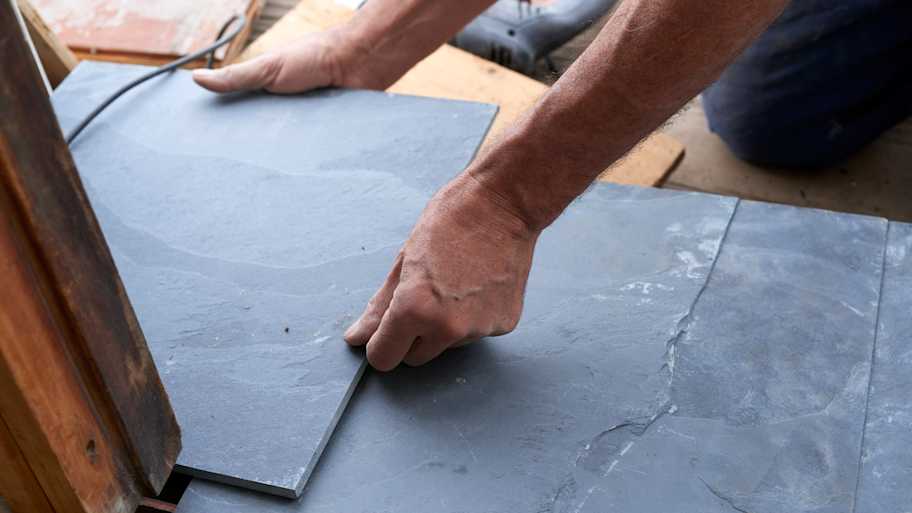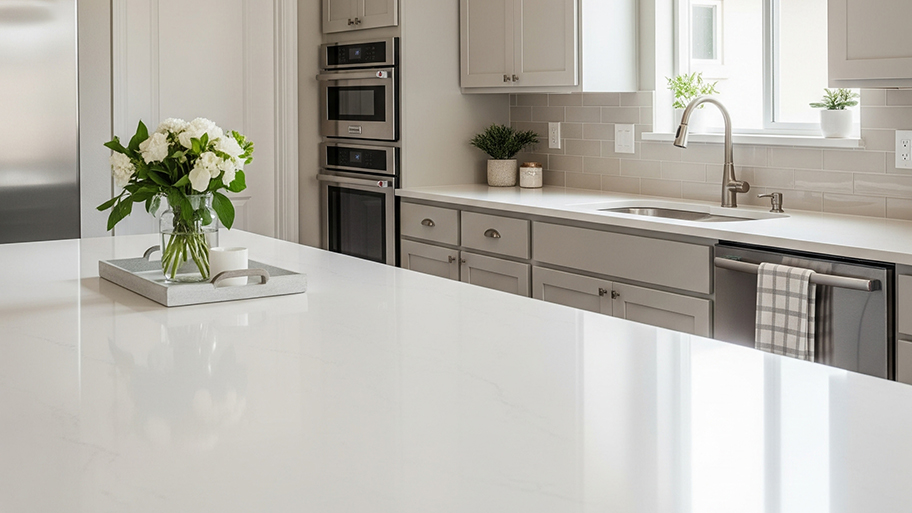
The cost of porcelain countertops is affected by many factors, primarily the material's type (tile or slab) and finish, as well as your counter’s size and shape.
Get a clean slate with this upscale flooring option


Slate tile is a durable, long-lasting flooring option that holds up well to heavy traffic.
For maximum stain resistance, slate tile needs to be resealed periodically.
Slate tile is a more expensive flooring option but lasts longer than many other types of flooring.
This flooring requires specialized professional installation and can be difficult to repair or replace.
Slate tile is a beautiful, unique choice to make your floors really stand out. Its distinctive aesthetics lends an upscale look to your floors and can last for decades of heavy use. Like any flooring material, slate tile has its pros and cons—we explore some of the benefits and drawbacks of slate tile so you can decide if this flooring option is right for your home.
Slate tile is known for its distinctive layered look, created by sedimentary rock and other materials compressed over time into solid stone. Slate tiles are often dark in color and have rough, natural edges. These tiles are strong, durable, and long-lasting, making them a great choice for high-traffic areas.
| Pros | Cons |
|---|---|
| Durable | Complex installation |
| Long-lasting | Expensive |
| Easy to clean | Requires sealing |
| High-end aesthetics | Difficult to repair |
Slate tile flooring has a number of advantages compared to other flooring options. Here are some of the benefits of slate tile.
Slate tile is resistant to cracks, chips, scratches, and breaks, making it an ideal tile for kitchen floors, bathrooms, hallways, and other high-traffic spots. Slate tile holds up well to heavy use under a variety of conditions, so if your household is hard on your floors, it can be a good choice.
Slate tiles, when installed and maintained correctly, can last up to 50 to 100 years, making them far more long-lasting than other flooring materials. Slate is a great option if you don’t want to have to worry about replacing your flooring for decades to come.
Slate tiles are relatively easy to clean, needing only regular sweeping and periodic mopping with mild soap. They dry quickly and don’t require specialized cleaning products or techniques to look great even years down the line.
Slate tiles are a premium flooring option, and you can tell by looking at them. Their high-end aesthetics add elegance to your home and add an upscale, polished look to otherwise utilitarian floors. They also go well with a wide variety of design choices, allowing you to change up the look of a room without having to replace the flooring.

Slate, even among other kinds of tile, is complex to install and should be installed by a qualified professional. Cutting slate requires specialized equipment and techniques, and your floors will need to be properly prepped to reduce the likelihood of flexing and other movement that can crack the tiles.
Slate flooring costs more than other flooring materials, at around $10 to $16 per square foot. The cost to install a tile floor made of ceramic, by comparison, is about $0.50 to $7 per square foot. While the initial cost to install slate tile is high, its longer lifespan means it won’t need to be replaced as quickly.
Slate tile can be extremely stain-resistant, but only if it’s properly sealed. Unsealed slate can discolor easily, so you’ll need to seal it every year or two to maintain its stain resistance.
Just like slate tile is difficult to install, it’s also more complex to replace or repair tile made of slate. Slate tile repair requires expert techniques to maintain the floor’s uniformity and reduce the risk of damage to the tiles. The cost to remove tile flooring made of slate is also higher than with other types of tile, so if you change your mind in the future, expect to pay more for removal.
Not sure you want to commit to slate tile? Consider one of these alternatives:
Ceramic tile
Porcelain tile
Marble
Granite
Concrete tile
Travertine
If you’re trying to decide if slate tile is right for your home, a local tile pro can help you weigh the benefits and drawbacks. If you have the budget for slate’s higher up-front costs and its longevity appeals to you, it can be a beautiful, durable option that adds aesthetic value to your home for decades to come. Be sure to consider whether you’re willing to keep up with regular resealing as well as potentially complex and costly repairs—if you are, this flooring may be the right choice for your home.
From average costs to expert advice, get all the answers you need to get your job done.

The cost of porcelain countertops is affected by many factors, primarily the material's type (tile or slab) and finish, as well as your counter’s size and shape.

Marble countertops have yet to go out of style, and likely won't any time soon. This strong, durable, and stunning material melds with most kitchen, bathroom, and even dining room designs. But how much do marble countertops cost to install?

Silestone® has long been a favorite of homeowners who like the look of quartz. Budget for your Silestone® countertop’s cost with this helpful guide.

Are you considering adding soapstone counters to your home? Here are the pros and cons of this countertop material to consider before making your decision.

Many savvy homeowners ask the question: Do quartz countertops need to be sealed? This guide explains the makeup of quartz and shares what you need to know about sealing.

Who to hire for stone tile and marble installation? Learn which pros handle the work, what they do, and how to compare your options. Start here.